Posts
-
Let's Read the 4e Monster Manual 2: Will-O'-Wisp
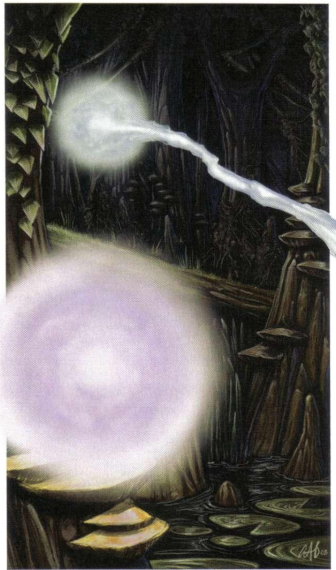
Copyright 2009 Wizards of the Coast. This post is part of a series! Go here to see the other entries.
Will-O’-Wisps in D&D are inspired by folklore, and their legend is in turn inspired by the natural phenomena that make swamp gas glow at night. I think they’ve been in the game since AD&D, though their exact lore might have changed a bit over the years.
The Lore
Will-o’-wisps are cruel fey spirits who feed on the fear and despair of other sapients. They like to hang out in swamps and marshes, whose natural mists and swamp lights provide them with hiding places. Their bodies are orbs of gauzy material, and they glow with an otherwordly light that has the power to lure unwary victims. It can also burn their flesh and drain their spirit.
Their tactics are pretty much iconic - lure victims to an isolated place full of hindering terrain and kill them in a way that produces maximum horror.
These creatures can communicate in Elven, and when they speak they have that cool effect where they brighten and dim in compass with their speech. They can also douse their light for better stealth, but this also prevents them from using it as a weapon.
The Numbers
Will-o’-Wisps are Small Fey Magical Beasts, and Level 10 Lurkers with 57 HP. They count as Insubstantial, taking only half damage from non-force attacks. They have low-light vision and a flight speed of 6 with Hover, and an altitude limit of 2 squares.
As mentioned above, wisps can turn their light on or off using the Fey Light ability (minor action 1/round). A darkened wisp has concealment and can make Stealth checks to become hidden, but it cannot attack. If a wisp is missed by an attack, it can Blink Out as a reaction. When this happens, the wisp darkens and teleports 5 squares. I guess it can make that Stealth check as part of this action too.
The wisp’s attacks are all light-based. The most classic one is of course Luring Glow. This is a Close Burst 20 that targets one non-blinded creature, which is another way to say it’s a ranged attack that doesn’t draw opportunity attacks. It targets Will, does no damage, pulls the victim 3 squares, and dazes it (save ends).
Once the victim is in range and vulnerable, the wisp is going to hit it with its basic Glimmer Wisp attack, which is Reach 2, targets Reflex, and does radiant damage. Once per encounter it can also use Spirit Drain on a bloodied target. This is a Reach 3 attack that targets Fortitude, deals psychic damage, weakens (save ends) and heals the wisp for 14 HP.
Sample Encounters and Final Impressions
Wisps are lurkers and have a couple of good stealth powers, but they don’t seem to have a lot of ability to take advantage of this stealth. Their best power is the very controller-y Luring Glow. When building wisp fights, you should pair them with other opportunistic monsters that can bring the hurt to those dazed characters.
Our sample encounter is level 9: two wisps and a quartet of spriggans (two powries, 2 thorns). Evil fairies all around.
-
Let's Read the 4e Monster Manual 2: Warforged
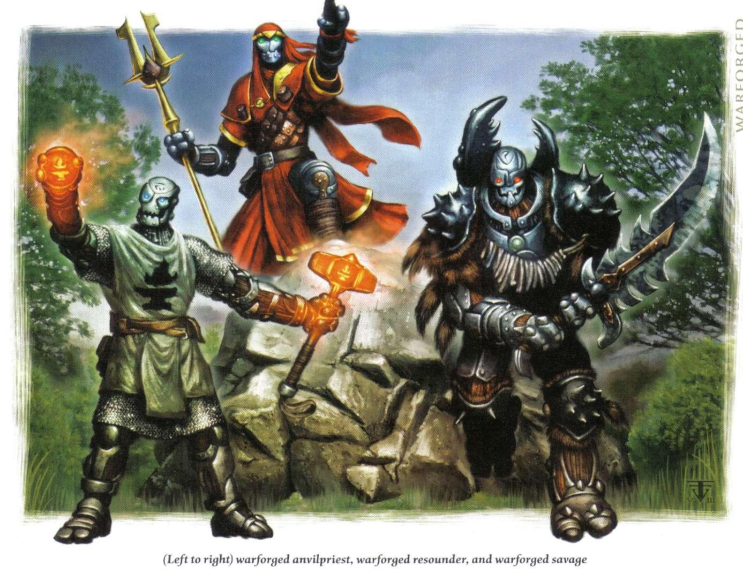
Copyright 2009 Wizards of the Coast. This post is part of a series! Click here to see the rest.
Warforged were originally introduced with the Eberron setting in 3e, as a playable option. They made their 4e debut in the first Monster Manual, which a couple of “monster” stat blocks for warforged and some abbreviated rules for using them as PCs.
Full support for playable warforged in 4e would arrive with the Eberron Player’s Guide, published in June 2009. However, just before that happened we’d get a few more NPC stat blocks here in the MM2, which was published in May 2009.
The basic lore for warforged remains the same as in the Monster Manual. The Eberron-specific info would only appear on the Eberron Player’s Guide, but I guess the two books were developed in parallel because the extra stat blocks we get here seem like a particularly good fit for that setting.
Their signature traits remain the same: the Living Construct keyword, a +2 to saves against ongoing damage and the Warforged Resolve encounter power (see the link above to read about what this does).
Warforged Resounder
These are warforged spellcasters whose power derives from a retained echo of the ringing sound of their creation forges. Their spells tend to have themes of sound and impact, dealing a mix of thunder and force damage. They wear robes and wield staffs, so I guess they’re meant to come across as “arcane”, but you could easily use their lore for a more priestly type since it’s so close to that of the Anvilpriest (below).
Resounders are Level 6 Artillery with 57 HP and the common traits described above. Their quarterstaves are weak melee attacks, so they prefer to stay away and cast thunder orbs (ranged 10 vs. Fortitude) that do good thunder damage and push 2 squares.
They also have a couple of encounter spells: Resounding Sphere is an area version of Thunder Orb that knocks prone instead of pushing, making it a good fight opener; and Rumble Staff is a “keep-away” melee power that does thunder damage, pushes 1 square, and knocks prone.
Their final encounter spell is the amusing Collision Bolt, a ranged attack that targets two enemies and slams them together. It works by dealing force damage to both targets, and sliding the second one 3 squares towards the first. If the slide ends with both targets adjacent to each other, they’re both knocked prone.
Warforged Savage
With an unfortunate name and a somewhat unfortunate illustration, this is a warforged who feels emotions more intensely than most of its kin, and channels all of that extra intensity into anger. It was likely produced in a forge belonging to the Lord of Blades, since the Cannith smiths tend to go for cool-headed discipline instead. It’s a Level 7 Brute with 98 HP.
This warforged has the Battlefield Tactics trait that was common in the MM1 entries, gaining a +1 to melee attacks when an ally is adjacent to their target. It also gains 4 temporary HP whenever it hits with an attack.
The warforged savage uses a scimitar to fight. This is a High-Crit weapon, and when it hits it deals a bit of automatic damage to another enemy adjacent to its target. It can use the weapon to attack in a Close Burst 1 (recharge 5+), and to perform a Wild Charge that deals heavy damage, and gives it a +3 AC bonus during the movement part of the charge. This recharges whenever the warforged hits two or more enemies with the burst attack. All of these maneuvers benefit from the scimitar’s High-Crit property.
Warforged Anvilpriest
Like the resounder, this spellcaster retains a bit of the power of its creation forge and uses that as a source of magic. The main difference is that the anvilpriest focuses on the searing heat of forge-fire. Despite the name, many anvilpriests aren’t all that religious. Some are real clerics, though, and a small number of them actually worship the creation forges themselves. I guess the latter are mostly found amid the Lord of Blades’ forces.
Anvilpriests are Level 8 Controllers with the Leader keyword and 89 HP. They wield a fiery warhammer that does bonus fire damage and inflicts a -2 AC penalty for a turn. They can use that to perform a Heat of Battle maneuver (recharge 4+), which is like a basic attack but replaces the AC penalty with ongoing fire damage.
In addition to this they have two encounter spells.
The first is Blunted Mind, an area burst that targets Will and inflicts psychic damage. It also inflicts a -2 penalty to attacks and a -4 penalty to damage on a hit - the first save improves this to a -2 damage penalty, and only the second removes it entirely. This only targets enemies, so it’s safe to cast into a messy melee.
The other is Mending Flash Fire, a close burst that deals fire damage to all enemies inside (vs. Reflex) and gives both the caster and any allies in the burst 5 temporary HP. If those allies are Warforged, they can also use their Warforged Resolve power as an immediate reaction to this power.
Warforged Titan
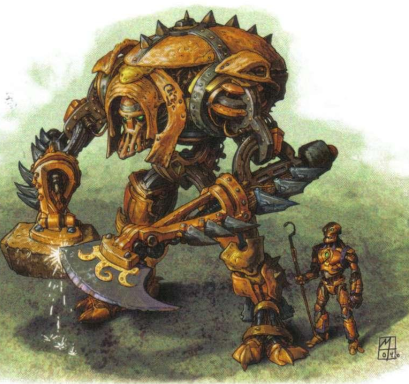
Copyright 2009 Wizards of the Coast. Titans were some of the earliest models of warforged developed by Cannith engineers. They’re as big and as powerful as their name implies, but they’re also only barely sapient. In a battle, they fulfill the same role as tanks or siege engines, but they need to be accompanied by smarter infantry or at least by a minder who can direct them. They’re loyal to whoever holds or displays a symbol of the titan’s creator, regardless of whom it may be or how long it’s been since their creation.
Warforged Titans are Huge Natural Humanoids with the Living Construct Keyword. They’re also Level 19 Elite Soldiers with 362 HP, which makes them plausible counters to Slaughterstone Constructs and other near-epic giant monsters.
These towering creatures fight with their built-in weapons. Their basic attack is a Reach 3 Axe with the same “splash damage” effect as the Savage’ scimitar above, and that also marks on a hit. As a minor action they can also use a Reach 3 Hammer that does more or less the same damage, slides the target 2 squares, and knocks it prone. It does a bit of damage even on a miss, likely from the shockwave. Both of these weapons enjoy the benefits of Threatening Reach.
Finally, the titan’s Unstoppable Charger trait makes it so a charge attack doesn’t end its turn. It can perform any actions it still has after charging, such as using a Move to shift or reposition, or a Minor action to perform a hammer follow-up.
Sample Encounters and Final Impressions
Warforged are people. You can find them fighting for any cause people tend to fight for. Good, evil, or just plain selfish. They’re relatively recent creations in Eberron, but other settings might have then as ancient survivors/relics of a fallen empire. Titans work well as McGuffins in that role, since they’ll obey anyone who displays the mark of their creator.
We have two sample encounters:
-
Level 7: A resounder, an anvilpriest, and 3 savages. Lord of Blades patrol?
-
Level 19: A cambion hellfire magus, a steel predator, and a warforged titan. Someone found themselves a few control amulets.
-
-
Let's Read the 4e Moster Manual 2: Vine, Predatory
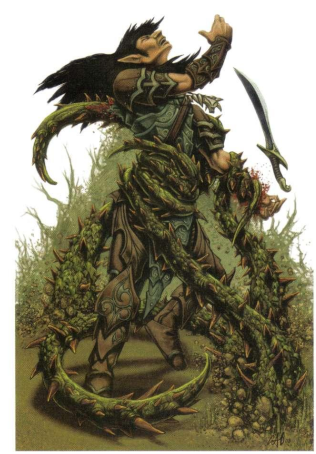
Copyright 2009 Wizards of the Coast. This post is part of a series! Click here to see the rest.
That’s the actual title of the entry, so we have another case of Old School Titling here. Dangerous plants have been a part of the game since its beginnings, and I bet a lot of the individual monsters collected in this entry appeared before in some form or another.
Lore-wise, there isn’t much on these other than “they exist”. They don’t have strange magical origins like some of the other plant creatures we saw before, they’re just ambulatory carnivorous plants with enough strength and mobility to hunt people. D&D worlds are already filled with impossibly lethal predators, so it’s not such a stretch to say some of those are plants.
All of the monsters in this entry are Beasts, which in rules terms means they behave like “animals” rather than like people. They also have the Plant keyword (obviously). Their Int score is 2, so their behaviors are all instinctive. Everything else varies per stat block.
Ambush Vine
The apex predator of the plant kingdom, ambush vines can hunt anywhere: on the surface, underground, and even in water. Wherever they are, they’re always hunting, and using the tasty nutrients of their victims to fuel their explosive growth rate. Ambush vines can form blights so vast they threaten civilization, and its rumored that this contributed to the fall of the old eladrin empire of Cendriane.
As their name implies, ambush vines are a lot more cunning than your average plant. They can burrow just under the surface or blend into the surrounding normal vegetation to wait for victims, and then launch surprise attacks against them.
Ambush Vines are Large Fey plants, and Level 16 Elite Controllers with 308 HP. They have tremorsense 20, and nothing in their stat block says they’re blind so I guess they can see as well even without eyes. Their speed is 6 in almost any mode of movement other than flight. They can move over the ground with Forest Walk, climb, burrow and swim.
A vine’s most basic attack is a Reach 2 Poison Lash that targets Reflex, deals physical damage, and inflicts ongoing poison damage. It can also attack with Lashing Vines in a Close Burst 4 pattern, which does more damage than the basic attack. It’s also super-effective against immobilized targets, dealing extra damage and healing the vine for 5 HP. As a minor action, the vine can use a Reach 4 Foot Snare to deal the same damage as the basic attack and knock a target prone.
Though ambush vines deal extra damage to immobilized foes, they can’t do the immobilizing themselves, so they must be paired with other monsters capable of it. Fortunately, they can make their own!
When the vine is first bloodied, it undergoes Rapid Growth as an emergency response, producing two Ambush Vine Shoot minions (see below). It can also make a minion voluntarily using Sprout Vine, a minor action which costs 10 of its own HP and produces a single minion.
Ambush Vine Shoot
This is the juvenile form of the ambush vine. It’s a Medium Fey plant, and a Level 15 Minion Controller. Their senses are the same as those of an adult specimen, though their only special movement mode is burrowing.
These minions have a single attack, Wrapping Vines, which deals minion-tier damage and restrains (save ends). “Restrained” is one step worse than “immobilized”: it roots the victim in place and inflicts a -2 penalty to attacks. A restrained target also counts as immobilized, so the shoot’s “parent” vine can deal extra damage against them.
The shoot also has a passive trait named Enwrap, which affects adjacent enemies and inflicts a -2 penalty to their saves against being immobilized or restrained.
Bloodthorn Vine
This is a vine with pale leaves and one single large thorn. It feeds by impaling victims on that thorn, which is hollow and capable of draining blood. As it does so, the vine’s leaves take on a reddish coloration.
Bloodthorn vines are Medium Natural plants, and Level 2 Soldiers with 41 HP. By the logic I’ve been using, them being low-level means they might occur near the archetypical Starting Village. This means they’re one more threat common civilians must be wary of in their daily lives, along with stirges, anhkegs, and giant ants. Bloodthorns are much less lively than Ambush Vines, having only a ground speed of 5 with Forest Walk and no special movement modes. They have Blindsight 10 but again are not blind themselves.
Their basic attack is a Striking Vine with no riders on its physical damage. The real danger here is the Impaling Thorn, which does the same damage and grabs the target. The vine can sustain the grab with a standard action to deal heavy automatic damage to the victim and heal 5 HP. It can use Pulling Vines as a minor action to shift 1 square and pull a grabbed victim along with it.
Fortunately, the bloodthorn vine can only impale a single victim at a time… but you can have multiple bloodtorn vines on the same encounter group.
Greenvise Vine
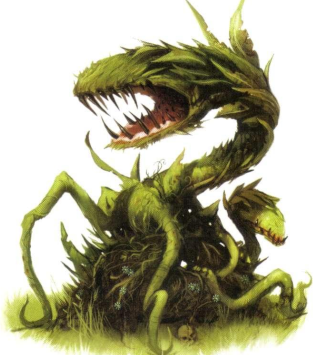
Copyright 2009 Wizards of the Coast. So named because “Piranha Plant” is already taken. This is a Large Natural plant, and a Level 7 Soldier with 83 HP. Its speed is only 4, so it relies on grabbing targets to prevent them from running away.
The greenvise’s basic attack is a Striking Vine, and they can also use an Ensnaring Vine vs. Reflex to do the same damage and grab the target. That’s when the big chomper comes into play: Vise Bite targets a grabbed victim’s Fortitude, deals a bit of initial damage, restrains, and inflicts ongoing physical damage. A save ends both the restrained condition and the ongoing damage but does not end the grab. You have to escape from that using the default rules.
The Greenvise also has the same Pulling Vines trait as the Bloodthorn.
Sample Encounters and Final Impressions
I actually have an easier time distinguishing between killer plants when I see them all together than when I see them in separate entries over multiple books.
We have three encounters here:
-
Level 2: 3 bloodthorn vines and 3 stirges. Probably competing to see who can drain the party dry first.
-
Level 9: 2 greenvise vines, 1 spectral panther, 3 quickling runners. The quicklings and the panther can be used to herd the party towards the slow-moving plants.
-
Level 17: 1 ambush vine, 1 lingerer fell incanter, 1 lingerer fell knight. Sinister vestiges of lost Cendriane.
-
-
Let's Read the 4e Monster Manual 2: Trolls
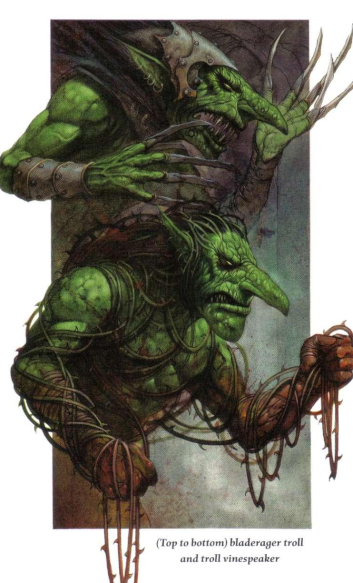
Copyright 2009 Wizards of the Coast. This post is part of a series! Click here to see the rest.
In a situation that has been common in this reading, we’re in a halfway place when it comes to trolls. The Monster Manual marks their debut in this edition, and the Monster Vault gives us a final selection of updated stat blocks. Here in the Monster Manual 2, published between those two books, we have a selection of trolls that expands the options from the MM, but is not yet updated for the MV’s math.
Ice Troll
It’s unclear from the text whether ice trolls are a variant troll species or just a variant culture. They inhabit the Frostfell, one of the world’s coldest regions, but occasionally make their way to slightly warmer climates. Ice trolls have a more complex and technically advanced culture than that of “typical” trolls. They know how to make weapons, and prefer to use them in combat instead of their claws. They also emanate a cold aura.
If you want to portray your trolls less universally hostile, ice troll communities could make good trading partners in cold regions, trading their weapons and crafts for other products they need. Ice troll mercenaries might also be found among the forces of anyone who sets up shop in the frozen regions of your campaign world.
The Numbers
Ice trolls are Large Natural Humanoids and Level 10 Soldiers with 109 HP. Their Emanating Cold aura (1) slows any enemies caught inside for a turn. They have a ground speed of 8.
Ice troll regeneration works exactly like that of standard trolls: Regeneration 10 plus Troll Healing that allows them to keep regaining HP after hitting 0. Both are shut down for a turn if the troll takes acid or fire damage.
This troll wears scale armor and fights with a maul. If their maul attack bloodies an enemy, Frenzied Strike allows them to make another free attack. This could lead to a big chain combo if the ice troll manages to hit several near-bloodied PCs, but most likely you’ll be looking at one extra attack when this triggers.
Weapon use would make ice trolls a lot more dangerous than standard ones in a “realistic” system like GURPS, but here it’s mostly for color since damage is entirely level-based. It does allow you to place magic weapons and armor as treasure by saying the troll was using them.
Bladerager Troll
This troll was updated for the Monster Vault, so we already saw its numbers on the MM/MV reading. A new bit of lore in this entry says that some of the weapons and armor implanted on a bladerager are magic, which gives GMs an excuse to place magic items as treasure in bladerager encounters. This makes them the only monster in the game to have literal loot drops.
Troll Vinespeaker
Here’s something you don’t see every day: a troll spellcaster with genius-level intellect! You go, vinespeaker! Break those stereotypes! Unfortunately the vinespeaker doesn’t break every troll stereotype, so it’s still Chaotic Evil. You’ll have to break that one yourself if your campaign calls for it.
Vinespeakers use a style of primal nature magic that involves wrapping themselves in thorny vines and letting their blood soak the plants to gain control over them. This would be lethal for any other practitioner, but for a troll it’s no trouble at all. With their magic power and high intelligence, vinespeakers tend to become leaders or revered advisors of larger troll communities.
The Numbers
Vinespeakers are Level 14 Controllers with 142 HP. They have Regeneration 10, Troll Healing, and the usual vulnerabilities, as well as the usual Speed 8.
They can use their claws to fight like a typical troll, but their vines give them many more options. They have a ranged attack named Ray of Thorns that deals physical damage, and an area burst attack named Thorny Burst that deals light physical damage and immobilizes (save ends). This also creates a zone of thorny difficult terrain that deals damage to those caught inside, and lasts until the end of the encounter. If any of these attacks bloodies a target, the vinespeaker gets to make a free claw attack. No target is specified, so any PC within reach will do fine.
Note: Thorny Burst is at-will. Vinespeakers can turn the entire battlefield into a spiky mess in no time at all. A good tactic for the is to spam this attack until there’s no more ground to cover or until the PCs are all immobilized, then target the most vulnerable foes with the single-target Ray.
Finally, they have an encounter ability named Chant of Power, which gives allies in within 5 squares 10 temporary HP and a +4 damage bonus while the temporary HP lasts. This works wonderfully as either a fight opener or a mid-fight boost.
Sample Encounters and Final Impressions
I like these MM2 trolls, they do a good job of subverting the troll stereotype.
We get three encounters:
-
Level 10: 2 ice trolls, 2 worgs, and 1 manticore. Lots of raw melee power in this one, with a maneuverable skirmisher thrown in.
-
Level 12: 3 bladeragers, 1 duergar blasphemer, 1 duergar hellcaller. Duergar diabolists are exactly the sort of person who’d make bladerager trolls.
-
Level 15: 4 war trolls, 1 destrachan far voice, 1 vinespeaker. The war trolls can more or less ignore the thorns. They’ll be slowed by the difficult terrain, but so will everyone else. The destrachan offers some artillery support and can stay far away from the thorn zones.
-
-
Let's Read the 4e Monster Manual 2: Troglodyte
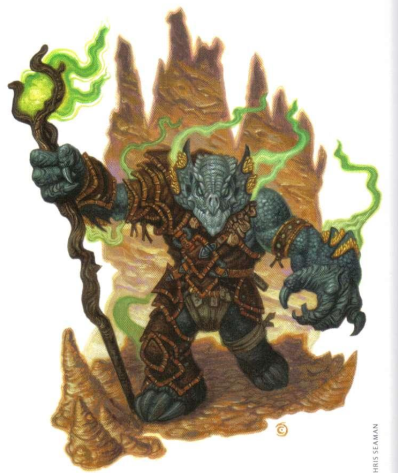
Copyright 2009 Wizards of the Coast. This post is part of a series! Click here to see the rest.
We already saw troglodytes in our reading of the Monster Manual and Vault, and their basic lore remains the same. We get a few additional entries with their own lore here.
Like before, these troglodytes are Medium Natural Humanoids with the Reptile keyword, and their signature ability is the Troglodyte Stench, an aura that inflicts a -2 penalty to attacks. They have Darkvision and a speed of 5.
Troglodyte Thrasher
We already discussed their lore in the MM/MV post, so I’m not going to repeat that discussion here. However we do get a bit of additional lore. It seems thrashers are actually nonsapient, and their fellow troglodytes keep them in cages when not using them as attack beasts. I wouldn’t use this “charming” bit of lore in my own campaigns.
Troglodyte Deepscourge
Deepscourges are spellcasters. Like some poisonscale lizardmen, they follow a tradition based on internal alchemy. The specific variant practiced by deepscourges centers around manipulating and empowering their natural malodorous secretions to turn them into damaging and debilitating spells. Like Curse Chanters from the MM/MV post, deepscourges act as priests and leaders of troglodyte tribes, or as advisors to those leaders.
Deepscourges are Level 9 Artillery with the Leader keyword and 78 HP. Their slime is turbocharged: it projects the same Troglodyte Stench aura as the others, but it also projects an aura of Dizzying Stench out to 10 squares! Despite the name this is actually a “buffing” effect, increasing the radius of the stench of any troglodytes inside by 1 square. I wonder if the auras of multiple deepscourges stack.
Their main ranged attacks are an at-will Debilitating Ray that deals physical damage and weakens the target for a turn if it’s inside a stench aura. The stat block doesn’t list an attack roll, but I guess this is an editorial error and it should target AC.
They can also attack with an area-effect Rancid Cloud (recharge 5+), which only affects “non-reptiles”, targets Fortitude, does more damage than the ray attack, and weakens for a turn.
When hit by an attack the deepscourge can project a Blinding Stench in a burst around itself, targeting Fortitude and blinding (save ends) with no damage. If that doesn’t give it space to move away, it will be forced to use its weak claws in melee.
Troglodyte Temple Champion
As the name implies, these are troglodyte holy warriors, usually tasked with guarding their temples. These temples usually honor Torog, but some are dedicated to even worse entities like Demogorgon or other demons.
The blessings they receive tend to be subtle, of the type that makes them smarter and more disciplined. They use a highly technical fighting style and carry much better equipment than the rank and file. Though champions can be most often found guarding a temple, they’re also sometimes sent on divine missions at the head of troglodyte expeditionary forces.
The Troglodyte Temple Champion is a Level 9 Soldier with 101 HP. It wears scale, wields a flail, and also carries 2 javelins into battle. The flail and javelins make up their basic attacks, and they also have a couple of special techniques. Sweeping Trip is an at-will maneuver that does a bit less damage than an attack and knocks prone. Whirlwind Attack is an encounter power that does basic attack damage in a Close Burst 1.
No marking mechanic here - the champion’s stickiness comes from their liberal use of Sweeping Trips to keep opponents prone at their feet.
Sample Encounters and Final Impressions
I find the Deepscourge notable for being the first troglodytew stat block that can’t be easily re-skinned into another humanoid opponent. Its abilities are all about the stench, both its own and that of its allies. It’s a uniquely troglodytic monster.
Other than that, my opinion on troglodytes hasn’t changed much.
There’s four sample encounters between levels 7 and 12, and they’re all assorted bands of troglodytes. Sometimes they’re accompanied by drakes, and one of them has a balhannoth that likely appears as an opportunistic predator during the fight.
subscribe via RSS